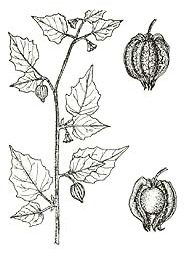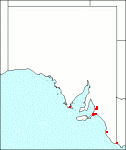Family: Solanaceae
Physalis peruviana
Citation:
L., Sp. Pl. edn 2:1670 (1763).
Synonymy: Not Applicable Common name: Cape gooseberry, ground-cherry.
Description:
Softwooded short-lived shrub to c. 1 m tall, unarmed; all parts densely pubescent with a tomentum of erect simple or glandular hairs; leaves alternate but often with a second one from the axillary bud, mostly c. 6 x 4 cm, ovate-acuminate, base cordate, margin entire or with a few blunt angular lobes, apex acuminate; petiole c. 2-3 cm long.
Inflorescence a solitary pedunculate flower in the leaf axil; calyx 1-1.5 cm long, densely pubescent, purplish, divided about half way into acuminate-triangular lobes; corolla 1.5-2 cm diam., rotate to shallowly 10-lobed, yellow with well defined purple-brown blotches towards the base, densely pubescent with pale yellowish dendritic hairs below the blotches and around the nectaries; filaments 3-5 mm long, purplish; anthers 4-4.5 mm long, bluish, pollen pale; ovary 2-2.5 mm diam., rounded, glabrous, disk a pale orange-yellow; style 5-7 mm long, erect, purplish; stigma capitate, expanded.
Berry 1.5-2 cm diam., globular, aromatic, a pale ochre-yellow when ripe, totally enclosed in the inflated angular c. 3-3.5 cm long calyx tube; seeds 1.75-2 mm long, discoid, minutely and shallowly reticulate.

| Flowering and fruiting branch, fruit surrounded by enlarged calyx and with calyx removed.
|
Image source: fig. 572A in Jessop J.P. & Toelken H.R. (Ed.) 1986. Flora of South Australia (4th edn).
|
Published illustration:
Purdie et al. (1982) Flora of Australia 29:fig. 46; Masefield et al. (1969) Oxford book of food plants, p. 127.
|
|
Distribution:
|
S.Aust.: SL, SE. All States. Native to South America, but has become naturalised in disturbed sites in warm temperate areas frequently in moist conditions.
|
Conservation status:
naturalised
Flowering time: July — Dec.
|

SA Distribution Map based
on current data relating to
specimens held in the
State Herbarium of South Australia
|
Biology:
No text
Uses:
P. peruviana has been widely cultivated as a minor fruit crop in the warm temperate areas of the world. The fruits are aromatic and palatable and can be eaten fresh or cooked.
Author:
Not yet available
|

